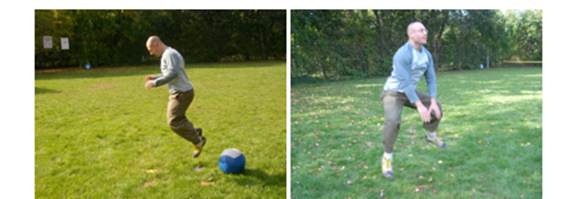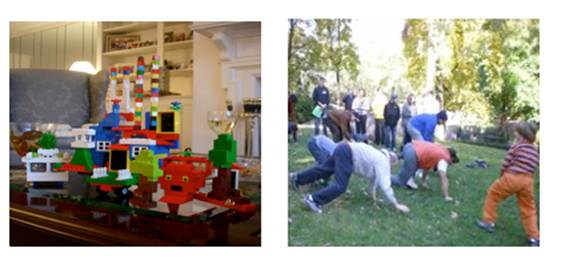Over, Under, and True: Generalization and Fitness

Over, Under, and True: Generalization and Fitness
“Bradley,” a highly motivated 5-year old athlete that I’ve just begun working with, was bouncing around the room, ecstatic over the colorful foot and hand-shaped spot markers that I’ve placed on the floor. Bradley jumps around with glee on the feet, over the feet, next to the feet, and on the hands as well. It is quite evident that Bradley has mastered the act of jumping. When we try a frog jump, with feet out wide and hands on the floor, he returns back to the same feet-together position from the beginning of the session. “Felix,” one of my older athletes on the spectrum, requires a good amount of physical prompting to perform a basic short hop. For both of these athletes, generalization is a key component in skill development.
In Felix’s situation, the baseline skill, jumping with two feet, needs to be addressed before we can move on to more complex activities. What should be mentioned is that during periods of high stimulation, Felix will engage in various physical stereotypes, including running back and forth and jumping up and down. The physical ability of jumping is present, but Felix is having difficulty generalizing the ability to specific and functional situations. Bradley is over-generalizing his jumping ability, performing the same jump when a new version (the frog jump) is demonstrated.
The author demonstrating the standard jump (left) as opposed to the frog version (right)
Discriminating between different hopping variations may appear trivial, though for movement and other life skills there exists an important learning process. I often refer to mythologies and assumptions about fitness and young populations, particularly those with special needs. A typical assumption about Felix may be “He’s very active, he jumps around a lot.” There are some vital follow-up questions that need answering, namely:
- Can he jump in a variety of different situations?
- Does he associate the word “jump” with the action of jumping?
- Will he jump unprompted or without a parent/instructor’s help?
- Can the jumping be used to build new, more complex skills?
I’ve seen plenty of teachers and parents attempt to teach a new skill on top of a pre-existing or already mastered ability. Students or learners who have a tendency towards over-generalization will usually perform the mastered activity. This is where the teaching process and skill acquisition usually break down.
The Problematic Approach
Instructor: Jennifer, hop on one foot!
Jennifer jumps on two feet
Instructor: That was really good hopping Jennifer!
Yes, reinforcing Jennifer is important. We want to motivate her and maintain a fun, supportive environment. If, however, the new skill is not being taught, the new skill will not be learned. Over-generalization occurs when there are too few options and attempts are not made to teach a variety of responses or skills. The assumption that “young people just know how to move naturally” is inaccurate, particularly when discussing special needs populations. There is a stack of research on the gross motor deficits and poor motor imitation skills of young people with autism. How do we expect physical skills to emerge when 1) Imbalances already exist 2) The learners have difficulty learning through observation/imitation and 3) New skills are not actively taught on top of baseline abilities.
Bradley can already perform that two-foot jump. It is a mastered skill and can certainly be applied to new activities and situations. The goal of fitness, or any educational program, is being able to generalize the material (math, reading, overhead throws with a 15 pound Sandbell) to different environments and circumstances. If the skill does not generalize, then what is the point of teaching it? Fitness is about enabling ourselves and others to perform at their physical best in a wide array of situations. Having many options in a physical repertoire will greatly enhance success in daily living and independence. If Bradley can already perform one type of jump, it is time to expand that class of abilities. We may want to teach:
- Single foot hops
- Backwards or lateral (side-to-side) jumps
- High jumps
- Jumping and throwing a ball
Physical fitness skills are a lot like Lego’s (if they still exist at the time this article is published). You start with a foundation and then build up, around, and through. Motor sequencing, an enormously difficult ability for many young people on the autism spectrum, can be improved through chaining different activities together. This type of activity was once called an “obstacle course” in phys ed. Now, I’m not sure what the video game equivalent would be.
Successful Lego-ing requires a sturdy foundation, so true with physical fitness
Attempting to teach Felix too many different ways to jump is not going to be the best plan of action. Selecting two jumps to begin with would be reasonable and provide great physical stimuli without being overly demanding. Forward and backwards hops/jumps are great for both motor planning and discriminating between directions. Our initial jumping program may look something like this:
I) Forward Jump
Steps:
1) stand on two spot markers
2) Bend knees
3) Jump forward
4) Step back to spot markers
II) Backwards jumps
Steps:
1) Stand on two spot markers
2) Bend knees
3) Jump backward
4) Step forward to spot markers
Teaching discrimination effectively requires a combination of labeling and behavior-specific praise. Suppose Bradley is now learning the frog hop and we are also including the previously mastered target of the two-foot jump.
The Effective Approach
Instructor: Bradley, do a frog hop
(Bradley performs the frog hop correctly)
Instructor: Awesome job doing that frog hop! I love the way you had your feet out wide!
The Effective Approach with Error Correction
Instructor: Bradley, do a frog hop
(Bradley performs the frog hop incorrectly, over-generalizing and performing the two-foot hop).
Instructor physically prompts Bradley back to starting point
Instructor: Let’s try a frog hop (demonstrates frog hop for Bradley and/or provides physical prompt or guidance so that Bradley performs the frog hop successfully)
Instructor: Great job doing that frog hop!
Physical fitness is developed, maintained, and enhanced through appropriate teaching and activities, along with exposure to a variety of movements. Fitness is as much a life skill as any other in school (and home), and even more important for long-term health and happiness. Whether in the PE class, the classroom, at home, or a therapeutic environment, fitness programs can enhance learning, self-esteem, and independence. Carefully assessing current abilities will allow for intelligent goal-setting and creating a dynamic fitness curriculum. Generalization is an important life skill, and for young people with autism and related special needs, it is key to provide them not only with the tools, but the ability to use them properly.
Eric Chessen, Founder of Autism Fitness, contributed a chapter on physical activity to the new book “Autism Tomorrow” published by The Center for AAC and Autism and Autism Today. Visit Eric Chessen at www.AUTISMFITNESS.com
Helpful Articles
- Fitness Challenge
- Workout Routine for Both You and Your Baby
- Playground Workout for Mom
- Get Your Heart Pumping with These Free and Easy Tips
- The Greatest Gift Of All Regaining Your Health & Your Groove
- Life as We Grow It: Fitness as a Life Skill for Special Needs Populations
- Turning Physical Fitness into Fun for Life
- The Family Factor of Five: Making Time for Fitness (and Actually Doing It)
- The 7 Habits of Highly Successful Fitness Programs
- 4 Exercise Progressions, 5W’s, and an H
- Waving Not Drowning: The Process of Making Fitness Fun
- Looking for a Fun Family Exercise? How About Parkour!





Hi, I read your blog regularly. Your humoristic style is awesome, keep up the good
work!